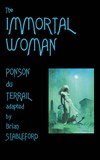The Immortal Woman
NOTE: YOU ARE PURCHASING AN E-BOOK, NOT A PAPER BOOK. WHEN ORDERING, PLEASE SPECIFY IN THE COMMENTS IF YOU PREFER A PDF OR AN EPUB FILE. THE FILE WILL BE E-MAILED TO YOU AS SOON AS PAYMENT IS RECEIVED.
THE IMMORTAL WOMAN
by Pierre-Alexis Ponson du Terrail
adapted by Brian Stableford
cover by Mike Hoffman
When one is as beautiful as you are, one can have as much blood as one wants.
In 1675, a female vampire possessing the secret of immortality was burned alive. Forty-five years later, during a dinner at the table of the French Regent, her then-lover, Marquis de la Roche-Maubert, discovers that another guest, Chevalier d'Esparron, is in love with the same immortal woman. However, her attraction to him is not to satisfy her hunger for blood, but to implement one of the greatest secrets of alchemy: the transmutation of lead into gold!
Pierre-Alexis Ponson du Terrail (1829-1871) was a French popular writer and a master of the serialized novel, having penned over 200 such works in 20 years. He is justly famous for his character of Rocambole and his ground-breaking horror novel, The Vampire and the Devil's Son (1852). The Immortal Woman (1852) is a forgotten masterpiece of early vampire fiction, and another of Ponson's classic flirtations with the supernatural.
Contents:
La Femme Immortelle (1869)
Introduction and Notes by Brian Stableford.
READ THE REVIEWS...
Ponson, the author, was (as the blurb tells us) a writer of the serialised novel and so there are similarities between this and the classic penny-dreadful Varney the Vampire, not least in some of the errors that creep into the narrative as Ponson forgets (or ignores) details previously mentioned in the text. Not that this takes away from the book, which still maintains a read-ability today.
The vampirism in the book is not real, rather it is quickly identified as a trick but certain characters maintain a belief in it through the entire length of the novel. The book is actually a tale of revenge and more thriller/swashbuckler than horror. Be that as it may, the lore included is interesting. The vampire is said to feed from the neck and, when her old lover the Marquis de la Roche-Maubert tells his tale, he says that she tried to pass off the pinprick at his neck by suggesting that one of her hairpins had scratched him. The immortal woman suggests that she can make another immortal by slowly draining every drop of their blood and then “infuse your veins with a young and generous blood. For that, it will be sufficient to give you a kiss every night.” Both the scratch and the kiss brought aspects of the later Dracula to mind. Mina mistakes the bite on Lucy for a scratch with a safety pin and the ‘brides’ have kisses (or bites) for Jonathon. Interestingly there was mention of the vampire’s hair having moved from black to blonde, reminiscent (as Stableford points out) to Feval’s the Vampire Countess, though the device was not expanded upon and was quickly lost. There is also use, in plot, of a Magic Lantern.
All in all, more fascinating 19th century French vampire literature.
Taliesin
